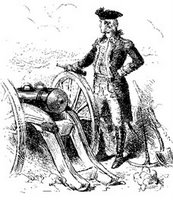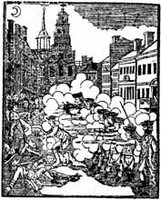Sybil Ludington: the legend’s beginning
I can't help but notice that one of the searches that commonly makes Boston 1775 pop up on Google is "Sybil Ludington," even though I've written only one posting about her, and that a skeptical one. So in the interests of completeness and a shameless grasp for ratings (it is still November, after all), I'm posting the text on which her legend is based and some more commentary.
The crucial passage is from Willis Fletcher Johnson’s Colonel Henry Ludington: A Memoir, published in New York by Lavinia Elizabeth Ludington and Charles Henry Ludington in 1907. Of the British raid on 26 Apr 1777, Johnson wrote:
At four o’clock Danbury was fired. At eight or nine o’clock that evening a jaded horseman reached Colonel Ludington’s home with the news. We may imagine the fire that flashed through the veteran’s veins at the report of the dastardly act of his former chief. But what to do? His regiment was disbanded, its members scattered at their homes, many at considerable distances. He must stay there, to muster all who came in. The messenger from Danbury could ride no more, and there was no neighbor within call.Already we see the poetic language, the dire details, the emphasis on a lone young female, and the comparison to Paul Revere—all hallmarks of the Sybil Ludington legend in the decades to come. But we don't see any sources specified for this episode, anywhere in the book. Furthermore, as I discussed before, Johnson was a journalist for hire, his book was published by the Ludington family itself, and this first version of Sybil’s story dates from 125 years after the event it describes. So as a historical authority, this passage is the equivalent of me telling you about something very heroic one of my relatives did in 1881 with no documentation.
In this emergency he turned to his daughter Sibyl, who, a few days before, had passed her sixteenth birthday, and bade her to take a horse, ride for the men, and tell them to be at his house by daybreak.
One who even now rides from Carmel to Cold Spring will find rugged and dangerous roads, with lonely stretches. Imagination can only picture what it was a century and a quarter ago, on a dark night, with reckless bands of “Cowboys” and “Skinners” abroad in the land. But the child performed her task, clinging to a man’s saddle, and guiding her steed with only a hempen halter, as she rode through the night, bearing the news of the sack of Danbury.
There is no extravagance in comparing her ride with that of Paul Revere and its midnight message. Nor was her errand less efficient than his. By daybreak, thanks to her daring, nearly the whole regiment was mustered before her father’s house at Fredericksburgh, and an hour or two later was on the march for vengeance on the raiders.
Many descriptions of Sybil Ludington claim that her ride had a significant effect. For instance, the article at About.com says that the men she summoned “were able to stop the British advance and push them back to their boats, in the Battle of Ridgefield.”
That reveals a misunderstanding of the British goals and outcome. The Danbury raid, like several other raids by the British military on southern Connecticut during the war, was designed to destroy American military supplies, disrupt shipping, and discourage raids on Long Island, but not to take and hold territory. As this Connecticut SAR page describes, the British troops landed, marched north to Danbury and set American supplies ablaze, then marched south to Ridgefield to rendezvous with their boats. Continental troops under Gen. David Wooster (above) and Benedict Arnold tried to cut off the British raiders, but didn't succeed.
Thus, the Ludington regiment would not have been “able to stop the British advance”; the raiders were already withdrawing. The Americans actually tried to keep the British from their boats, not “push them back to their boats.” And the Americans lost. Although the British took more casualties, they achieved their goals, Wooster died, and the Danbury raid is considered a British victory. But a legend shouldn’t end that way, so we rewrite the history a bit to make Sybil’s ride produce an American victory.
The 30 April 1777 Connecticut Journal printed a detailed account of the Danbury raid, also stressing American accomplishments to keep up the wartime spirit. However, that article didn’t mention troops from Dutchess County, New York—Col. Ludington’s militia regiment. (In contrast, “Col. Luttington” is mentioned in the New England Chronicle's account of a British raid on the Tarrytown area on 5 October; “they endeavoured to surround him, which he perceiving, ordered his men to retreat.”) Maybe the New York militiamen were there; maybe they were on their way but didn’t make it in time for the serious fighting; maybe the whole story is a myth. In any event, we still don’t have any sources on the Ludingtons’ roles from before the twentieth century.





